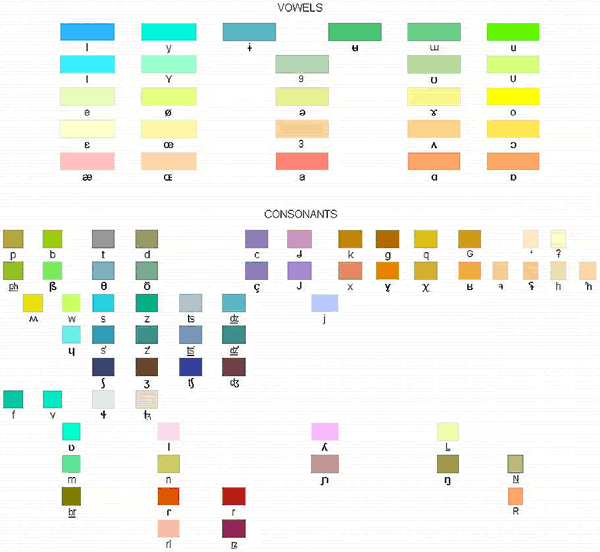The Color alphabet on the base of IPA is worked out by Vitaly Vetash, the Russian painter and linguist. The first varient of the color alphabet was done in 1983, on the base of psycholinguistic investigations. The model is based on the kinship of psychological meaning of sounds and colors.
In the 1970's Kaliningrad University scientific group of A.P.Zhuravlev had found fixed correspondance between vowels and colors statistically (most of people feel A as red, loud, open, active). Exploring the use of sounds in poetry, according this psycholinguistic model, the group had got interesting results: e.g. when counting the frequency of all the sounds in famous poems about autumn, these poems turned to be colored in yellow-red tints, etc.
According the system of Goete (which now is used in T.V. transmission), the whole variety of colors is based on fusion of 3 main rays (red, yellow and blue), light and shadow. A similar law we can find in phonetics, where the variety of vowel comes from the combination of the triangle of the main sounds (A, I, U). Colors of vowels are: A is red, I - blue, U - green (not yellow, but green, as used on TV). Green is a more fixed tint, than yellow, and sound is more material, than color.
It's possible to extend the system, including consonants (which was done by V.Vetash). Vowels, being the most resonant between phonemes, represent clear colors, and consonants have more complicated formant structure, representing complex tints of colors. We can find color tints for them according the place of their formation, connected with their acoustic characteristics (represented in IPA table). So the colors of consonants can be considered as derivative from vowels, close to them:
According the psycholinguistic investigations of Zhuravlev, one can give to non sonorous consonants darker colors than to sonorous ones, voiced ones have brighter colors than voiceless ones, and fricatives are more colored than plosives. That is, brightness depends on sonority: from rich colors (of sonants) to dry tints (of voiceless plosive sounds). Sonorous consonants, having more clear colors, are more close to vowels (R is ruby-colored, and burr R is orange; velar L is yellow-white and palatal L is white-rosy. Nasal vowels: mat-green M, mat-beige N, light-violet Y, dark-yellow W).
Below the color scheme according the table IPA (International Phonetic Alphabet) is represented. It shows that tints of kindred sounds are close. However, plain (flat) reproduction of sounds doesn't reflet the character of sounds exactly, because in the strict way one has to reproduce the texture also. Thus, colors of vowels must have additional luminescence, and consonants produce material sensations. For example, sibilants (S, Z, TS) could be reflected by metallic surface, and gutturals coinside with shaggy (wooden or board) surface. A dim, lackered surface fits for resonant sounds (L,M,N etc.).

For word reproduction on the base of the color-alphabet, it wouldn’t be right to alternate colors of sounds in the equal proportions. The appropriate model could be like this:

More information about the Colorbet
http://www.astrolingua.spb.ru/ENGLISH/colorbet.htm
If you have any questions about the Colorbet, you can contact Max at: semiravet@yandex.ru
Constructed scripts for: Ainu | Arabic | Chinese languages | Dutch | English | Hawaiian | Hungarian | Japanese | Korean | Lingala | Malay & Indonesian | Persian | Tagalog / Filipino | Russian | Sanskrit | Spanish | Taino | Turkish | Vietnamese | Welsh | Other natural languages | Colour-based scripts | Tactile scripts | Phonetic/universal scripts | Constructed scripts for constructed languages | Adaptations of existing alphabets | Fictional alphabets | Magical alphabets | A-Z index | How to submit a constructed script
[top]
You can support this site by Buying Me A Coffee, and if you like what you see on this page, you can use the buttons below to share it with people you know.

If you like this site and find it useful, you can support it by making a donation via PayPal or Patreon, or by contributing in other ways. Omniglot is how I make my living.
Note: all links on this site to Amazon.com, Amazon.co.uk
and Amazon.fr
are affiliate links. This means I earn a commission if you click on any of them and buy something. So by clicking on these links you can help to support this site.
[top]